标签:nbsp mamicode rip lvs group 开启 免密 nec 远程连接
本案例要求先快速搭建好一个Ansible平台,并测试环境,要求如下:
准备如表-1所示的实验环境,操作系统为RHEL8,配置主机名称、IP地址、YUM源。

ansible原理:
控制端主机自带很多模块(模块就是脚本);
ansible通过ssh远程被管理主机,将控制端的模块(脚本)或命令传输到被管理主机;
在被管理端主机执行模块(脚本)或命令,执行不同的模块或命令可以实现不同的功能;
最后ansible退出ssh远程。
绝大多数模块(脚本)都需要参数才能执行成功!!!类似于shell脚本的位置变量!
拓扑结构如图-1所示。
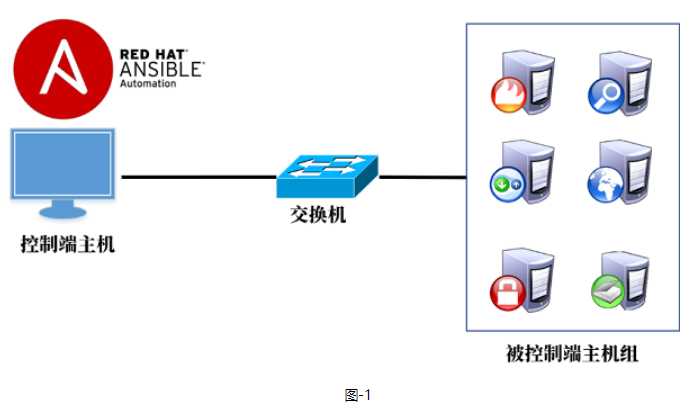
提醒:全天的实验不需要死记硬背每个模块的每个参数,所有参数都可以查看帮助!
实现此案例需要按照如下步骤进行。
步骤一:准备基础环境
控制节点要求:
1)Control控制节点
修改/etc/hosts,在文件中手动添加如下内容,修改该文件的目的是做域名解析。
[root@control ~]# vim /etc/hosts #修改文件,手动添加如下内容(不要删除文件原来的内容)
192.168.4.253 control
192.168.4.11 node1
192.168.4.12 node2
192.168.4.13 node3
192.168.4.14 node4
192.168.4.15 node5
如何验证?
[root@control ~]# ping node1 #可以使用ping命令依次ping所有域名
配置SSH密钥实现免密码登录(非常重要)
Ansible是基于SSH远程的原理实现远程控制,如果控制端主机无法免密登录被管理端主机,后续的所有试验都会失败!!
[root@control ~]# ssh-keygen -f /root/.ssh/id_rsa -N ‘‘ #生成ssh密钥
#-f指定密钥文件存放在哪个目录,文件叫什么名字,-N ‘‘设置密钥的密码为空
[root@control ~]# for i in node1 node2 node3 node4 node5
do
ssh-copy-id $i
done
#拷贝密钥到远程主机
#提示:拷贝密钥到远程主机时需要输入对方电脑的账户密码才可以!!
#拷贝密钥到node1就需要输入node1对应账户的密码,拷贝密钥到node2就需要输入node2对应的密码
如何验证?
警告:如果有任何一台主机远程还需要密码,就不要往下继续操作,后面实验都会失败!!!
[root@control ~]# ssh node1 #使用ssh命令依次远程所有主机都可以免密码登录
2)部署Ansible软件(仅Control主机操作,软件包在ansible_soft目录)。
[root@control ~]# tar -xf ansible_soft.tar.gz [root@control ~]# cd ansible_soft [root@control ansible_soft]# dnf -y install *
被控制节点要求:
步骤二:修改配置文件
主配置文件说明:
主配置文件ansible.cfg(主配置文件的内容可以参考/etc/ansible/ansible.cfg)
ansible配置文件查找顺序
首先检测ANSIBLE_CONFIG变量定义的配置文件(默认没有这个变量)
其次检查当前目录下的./ansible.cfg文件
再次检查当前用户家目录下~/ansible.cfg文件
最后检查/etc/ansible/ansible.cfg文件
1) 修改主配置文件。
[root@control ~]# mkdir ~/ansible
[root@control ~]# vim ~/ansible/ansible.cfg
[defaults]
inventory = ~/ansible/inventory
#主机清单配置文件(inventory可以是任意文件名),英语词汇:inventory(清单、财产清单)
#forks = 5 #ssh并发数量
#ask_pass = True #使用密钥还是密码远程,True代表使用密码
#host_key_checking = False #是否校验密钥(第一次ssh时是否提示yes/no)
2) 修改主机清单文件(清单文件名必须与主配置文件inventory定义的一致)。
[root@control ~]# vim ~/ansible/inventory
[test] #定义主机组(组名称任意)
node1 #定义组中的具体主机,组中包括一台主机node1
[proxy] #定义主机组(组名称任意),英语词汇:proxy(代理人,委托人)
node2 #proxy组中包括一台主机node2
[webserver]
node[3:4] #这里的node[3:4]等同于node3和node4
[database]
node5
[cluster:children] #嵌套组(children为关键字),不需要也可以不创建嵌套组
webserver #嵌套组可以在组中包含其他组
database
沿用练习一,练习Ansible ad-hoc具体应用,要求如下:
Ansible ad-hoc是一种通过命令行批量管理的方式,命令基本格式如下:
格式:ansible 主机集合 -m 模块名 -a "参数"
实现此案例需要按照如下步骤进行。
步骤一:测试环境
1)查看主机列表
[root@control ~]# cd ~/ansible #非常重要 [root@control ansible]# ansible all --list-hosts #查看所有主机列表 # --list-hosts是ansible这个命令的固定选项,如同ls -a一样(-a是ls命令的固定选项) #英语词汇:list(列表,清单)、host(主机、主办、主人)
2) 测试远程主机是否能ping通。
当需要远程多个主机或者多个组时,中间使用逗号分隔!!!
[root@control ansible]# ansible node1 -m ping #调用ping模块 [root@control ansible]# ansible node1,webserver -m ping
常见报错(有问题可以参考,没问题可以忽略):
node1 | UNREACHABLE! => {
"changed": false,
"msg": "Failed to connect to the host via ssh: Permission denied (publickey,gssapi-keyex,gssapi-with-mic,password).",
"unreachable": true
}
问题分析:
英语词汇:Failed(失败),connect(连接),to(到),host(主机),via(通过)
permission(权限),denied(被拒绝)
Failed to connect to host via ssh(通过ssh远程连接到主机失败)
Permission denied(因为无法连接,所以报错说权限被拒绝)
解决办法:手动ssh其他主机(如node1),看看是否可以实现免密码登录。
Ansible的原理是基于ssh远程管理,如果无法实现免密码登录,后面的实验无法成功!
如何实现免密码登录,可以参考案例上面的命令,或者第一阶段知识。
提示:该模块虽然叫ping,但是它不会发送任何ICMP协议的ping数据包,控制端主机仅仅是ssh远程被管理端主机,检查其是否有python环境,能顺利远程并且有Python环境就会返回正确的提示信息,否则报错。拓扑如图-2所示。
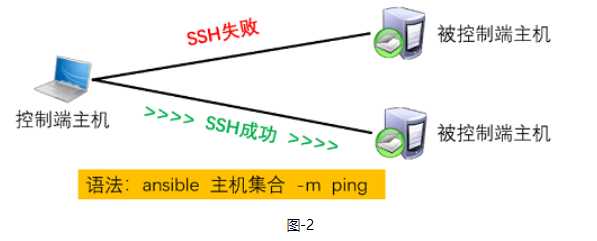
3)快速入门。
模块就是脚本(多数为Python脚本),多数脚本都支持参数,默认模块为command。
[root@control ansible]# ansible node1 -m command -a "uptime" #查看CPU负载 [root@control ansible]# ansible node1 -m command -a "uname -r" #查看内核版本 [root@control ansible]# ansible node1 -a "ip a s" #查看网卡信息 [root@control ansible]# ansible all -a "date" #查看时间
拓扑如图-3所示。

通过ansible-doc获取帮助。
[root@control ansible]# ansible-doc -l #列出所有模块 [root@control ansible]# ansible-doc -l | grep yum #在所有模块中过滤关键词 [root@control ansible]# ansible-doc yum #查看模块帮助
4)Shell模块。
command和shell模块的区别,command不支持bash的特性(bash有哪些特性可以参考Shell课程第一天的PPT),如管道和重定向等功能,但是shell模块可以支持。
不可以使用shell模块执行交互命令,如vim、top等。
[root@control ansible]# ansible test -m command -a "ps | wc -l" #报错 [root@control ansible]# ansible test -m command -a "ls &" #报错 [root@control ansible]# ansible test -m shell -a "ps aux | wc -l" #进程数量 [root@control ansible]# ansible test -m shell -a "who" #登陆信息 [root@control ansible]# ansible test -m shell -a "touch /tmp/txt.txt" #使用shell模块创建文件会有Warning警告提示,正常!!!
5)script模块
script模块会把-a后面的脚本拷贝到被管理端主机,然后执行这个脚本。
[root@control ansible]# vim ~/ansible/test.sh
#!/bin/bash
dnf -y install httpd
systemctl start httpd
[root@control ansible]# ansible test -m script -a "./test.sh"
#test是主机组的名称,-m调用script模块,-a后面的./test.sh是上面创建脚本的相对路径和文件名
#./是当前目录的意思,在当前目录下有个脚本叫test.sh
拓扑如图-4所示。

如何验证?
因为ansible远程的是node1,所以打开node1这台电脑,查看下是否安装了httpd软件、是否启动了服务。
[root@node1 ~]# rpm -q httpd [root@node1 ~]# systemctl status httpd
沿用练习二,继续练习Ansible ad-hoc应用案例,具体要求如下:
很多ansible模块都具有幂等性的特征。
幂等性:任意次执行所产生的影响均与一次执行的影响相同。
步骤一:file模块
file模块可以创建文件、目录、链接;修改权限与属性等(ansible-doc file)
[root@control ansible]# ansible test -m file -a "path=/tmp/file.txt state=touch" #远程test组中所有主机,新建文件,path后面指定要创建的文件或目录的名称 #state=touch是创建文件,state=directory是创建目录 ## 验证: 到node1主机,使用ls /tmp/file.txt看看文件是否被创建成功 ##
拓扑如图-5所示。
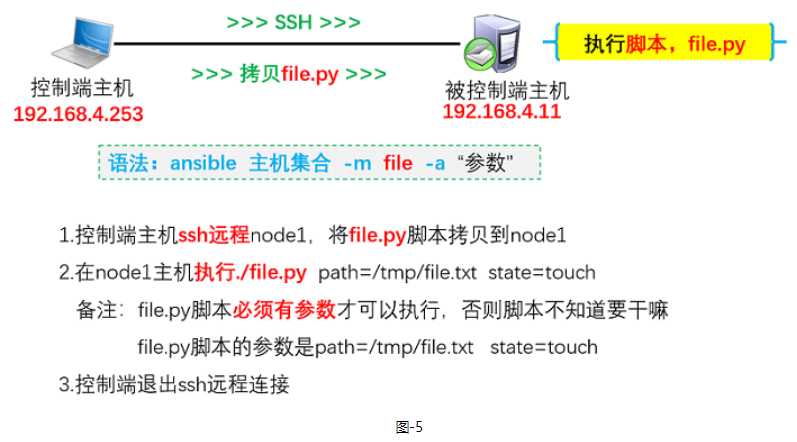
常见报错(有问题可以参考,没问题可以忽略):
node1 | FAILED! => {
… …
"changed": false,
"msg": "value of state must be one of: absent, directory, file, hard, link, touch, got: touc"
}
英语词汇:value(值),must(必须),be(是),of(…的),one(一个)
value of state must be one of:【state的值必须是后面给出的其中一个值】
解决办法:检查state的值是否有字母错误,上面报错例子中输入的是touc,不是touch
常见错误(有问题可以参考,没问题可以忽略):
node1 | FAILED! => {
… …
"msg": "Unsupported parameters for (file) module: nmae Supported parameters include: _diff_peek, _original_basename, access_time,
access_time_format, attributes, backup, content, delimiter, directory_mode,
follow, force, group, mode, modification_time, modification_time_format, owner,
path, recurse, regexp, remote_src, selevel, serole, setype, seuser, src, state,
unsafe_writes"
}
英语词汇:unsupported(不支持的),parameters(参数),supported(支持的)include(包括)
问题分析:file模块不支持nmae这个参数,它支持的参数包括哪些,后面有提示.
解决办法:检查模块的参数是否有字母错误,上面错误案例将name错写为nmae。
更多file模块的案例:
[root@control ansible]# ansible test -m file -a "path=/tmp/mydir state=directory" #远程test组中所有主机,创建目录,path后面指定要创建的文件或目录的名称 ## 验证:到node1主机,使用ls /tmp/看看tmp目录下是否有mydir子目录 [root@control ansible]# ansible test -m file -a "path=/tmp/file.txt owner=sshd group=adm mode=0777" #修改文件或目录权限,path后面指定要修改的文件名或目录名称,owner后面指定用户,group后面指定组,mode后面指定要修改的权限(0777中第一个0代表的是无特殊权限,如SUID、SGID等) ## 验证:到node1主机,使用ls -l /tmp/file.txt查看文件的详细信息是否正确 [root@control ansible]# ansible test -m file -a "path=/tmp/mydir state=absent" #state=absent代表删除(删除目录) [root@control ansible]# ansible test -m file -a "path=/tmp/file.txt state=absent" # state=absent代表删除(删除文件) [root@control ansible]# ansible test -m file -a "src=/etc/hosts path=/tmp/host.txt state=link" #给/etc/hosts文件创建一个链接文件/tmp/host.txt(src指定源文件,path是软链接文件名) #相当于执行命令 ln -s /etc/hosts /tmp/host.txt ## 验证:到node1主机使用ls -l /tmp/hosts查看文件是否为软链接
步骤二:copy模块
copy模块可以将文件拷贝到远程主机 (ansible-doc copy)。
[root@control ansible]# echo AAA > ~/a3.txt #新建测试文件 [root@control ansible]# ansible test -m copy -a "src=~/a3.txt dest=/root/" #把管理端本机的a3.txt文件,拷贝到test组中所有主机的/root/目录 #src代表源文件,dest代表目标文件 ## 验证:到node1主机使用ls /root/a3.txt查看是否有该文件
拓扑如图-6所示

步骤三:fetch模块
fetch模块与copy类似,但是作用相反,可以将其他主机的文件拷贝到本地(ansible-doc fetch)。
[root@control ansible]# ansible test -m fetch -a "src=/etc/hostname dest=~/" #将远程test组中所有主机的hostname文件下载到本地家目录 #src代表源文件,dest代表目标文件 [root@control ansible]# ls ~/ #使用ls查看下是否下载成功 #不能下载目录,如果需要下载目录,可以先打包后再下载
拓扑如图-7所示。

步骤四:lineinfile|replace模块
在修改单个文件的单行内容时可以使用lineinfile模块(ansible-doc lineinfile)。
[root@control ansible]# ansible test -m lineinfile -a "path=/etc/issue line=‘hello world‘" #在/etc/issue文件中添加一行内容hello world,默认添加到最后,line后面跟的是需要添加的文件内容 ## 验证:到node1主机执行命令cat /etc/issue查看文件内容是否正确 [root@control ansible]# ansible test -m lineinfile -a "path=/etc/issue line=‘hello world‘" #基于幂等原则,重复执行,不会创建多行内容 [root@control ansible]# ansible test -m lineinfile -a "path=/etc/issue line=‘insert‘ insertafter=‘Kernel‘" #将line后面的内容插入到/etc/issue文件中Kernel行的后面 #英语词汇:insert(插入),after(在…后面) ## 验证:到node1主机执行命令cat /etc/issue查看文件内容是否正确
lineinfile会替换一整行,replace可以替换关键词(ansible-doc replace)。
[root@control ansible]# ansible test -m replace -a "path=/etc/issue.net regexp=Kernel replace=Ocean" #将node1主机中/etc/issue.net文件全文所有的Kernel替换为Ocean #regexp后面是需要替换的旧内容;replace后面是需要替换的新内容 ## 验证:到node1主机执行命令cat /etc/issue.net查看文件内容是否正确
---------------------------------------------------------------------------
沿用练习三,继续练习Ansible ad-hoc应用案例,具体要求如下:
步骤一:user模块
user模块可以实现Linux系统账户管理(ansible-doc user)。
[root@control ansible]# ansible test -m user -a "name=tuser1" #远程test组中的所有主机并创建系统账户tuser1,默认state的值为present,代表创建用户 ## 验证:到node1主机执行命令id tuser1查看是否有该用户
拓扑如图-8所示。
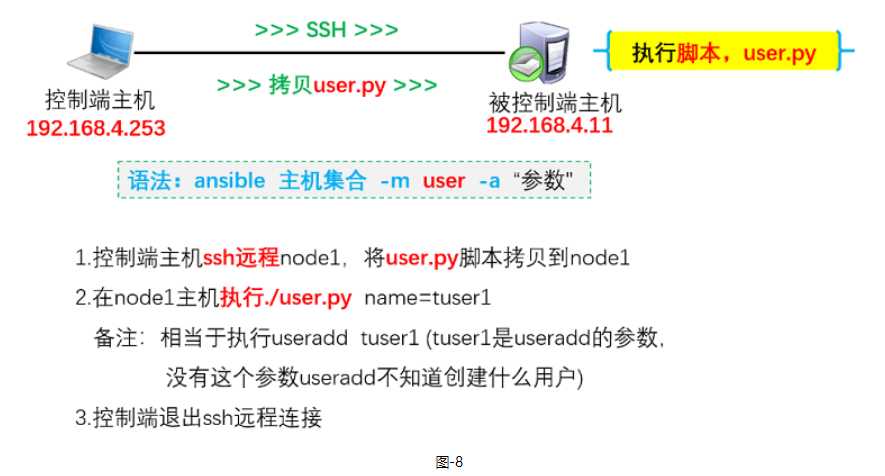
[root@control ansible]# ansible test -m user -a "name=tuser2 uid=1010 group=adm groups=daemon,root home=/home/tuser2" #创建账户并设置对应的账户属性,uid指定用户ID号,group指定用户属于哪个基本组 #groups指定用户属于哪些附加组,home指定用户的家目录 ## 验证: 到node1主机执行命令id tuser2查看是否有该用户
拓扑如图-9所示
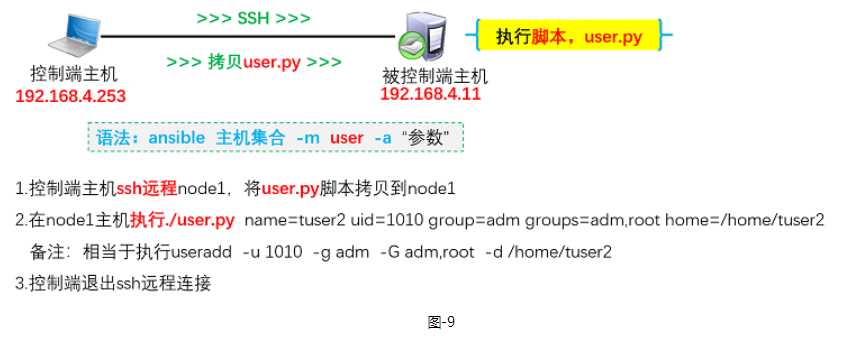
[root@control ansible]# ansible test -m user -a "name=tuser1 password={{‘abc‘| password_hash(‘sha512‘)}}"
#修改账户密码,用户名是tuser1,密码是abc,密码经过sha512加密
[root@control ansible]# ansible test -m user -a "name=tuser1 state=absent"
#删除账户tuser1,state=absent代表删除账户的意思,name指定要删除的用户名是什么
#账户的家目录不会被删除,相当于执行userdel tuser1
[root@control ansible]# ansible test -m user -a "name=tuser2 state=absent remove=true"
#删除tuser2账户同时删除家目录、邮箱,相当于执行userdel -r tuser2
步骤二:yum_repository模块
使用yum_repository可以创建或修改yum源配置文件(ansible-doc yum_repository)。
[root@control ansible]# ansible test -m yum_repository -a "name=myyum description=hello baseurl=ftp://192.168.4.254/centos gpgcheck=no"
#新建一个yum源配置文件/etc/yum.repos.d/myyum.repo
#yum源文件名为myyum,该文件的内容如下:
[myyum]
baseurl = ftp://192.168.4.254/centos
gpgcheck = 0
name = hello
## 验证:到node1主机ls /etc/yum.repos.d/查看该目录下是否有新的yum文件
[root@control ansible]# ansible test -m yum_repository -a "name=myyum description=test baseurl=ftp://192.168.4.254/centos gpgcheck=yes gpgkey=…"
#修改yum源文件内容
[root@control ansible]# ansible test -m yum_repository -a "name=myyum state=absent"
#删除yum源文件myyum
步骤三:yum模块
使用yum模块可以安装、卸载、升级软件包(ansible-doc yum),
state: present(安装)|absent(卸载)|latest(升级)。
[root@control ansible]# ansible test -m yum -a "name=unzip state=present" #安装unzip软件包,state默认为present,也可以不写 ## 验证:到node1主机执行命令rpm -q unzip查看是否有该软件 [root@control ansible]# ansible test -m yum -a "name=unzip state=latest" #升级unzip软件包,软件名称可以是*,代表升级所有软件包 [root@control ansible]# ansible test -m yum -a "name=unzip state=absent" #调用yum模块,卸载unzip软件包,state=absent代表卸载软件 ## 验证:到node1主机执行命令rpm -q unzip查看该软件是否已经被卸载
步骤四:service模块(ansible-doc service)
service为服务管理模块(启动、关闭、重启服务等),
state:started|stopped|restarted,
enabled:yes设置开机启动。
[root@control ansible]# ansible test -m yum -a "name=httpd" #调用yum模块,安装httpd软件包 ## 验证:到node1主机执行命令rpm -q httpd查看该软件是否被安装 [root@control ansible]# ansible test -m service -a "name=httpd state=started" #调用service模块,启动httpd服务 ## 验证:到node1主机执行命令systemctl status httpd查看服务状态 [root@control ansible]# ansible test -m service -a "name=httpd state=stopped" #调用service模块,关闭httpd服务 ## 验证:到node1主机执行命令systemctl status httpd查看服务状态 [root@control ansible]# ansible test -m service -a "name=httpd state=restarted" #调用service模块,重启httpd服务 [root@control ansible]# ansible test -m service -a "name=httpd enabled=yes" #调用service模块,设置httpd服务开机自启
步骤五:逻辑卷相关模块(ansible-doc lvg、ansible-doc lvol)
提示:做实验之前需要给对应的虚拟机添加额外磁盘,并创建磁盘2个分区
提示:可以使用前面学习过的parted或fdisk命令给磁盘创建分区
提示:这里的磁盘名称仅供参考,不要照抄!!!
lvg模块:创建、删除卷组(VG),修改卷组大小,
state:present(创建)|absent(删除)。
[root@control ansible]# ansible test -m yum -a "name=lvm2" #安装lvm2软件包,安装了lvm2软件后,才有pvcreate、vgcreate、lvcreate等命令 [root@control ansible]# ansible test -m lvg -a "vg=myvg pvs=/dev/sdb1" #创建名称为myvg的卷组,该卷组由/dev/sdb1组成 #注意:这里的磁盘名称要根据实际情况填写 ## 验证:到node1主机执行命令pvs和vgs查看是否有对应的PV和VG [root@control ansible]# ansible test -m lvg -a "vg=myvg pvs=/dev/sdb1,/dev/sdb2" #修改卷组大小,往卷组中添加一个设备/dev/sdb2
lvol模块:创建、删除逻辑卷(LV),修改逻辑卷大小,
state:present(创建)|absent(删除)。
[root@control ansible]# ansible test -m lvol -a "lv=mylv vg=myvg size=2G" #使用myvg这个卷组创建一个名称为mylv的逻辑卷,大小为2G ## 验证:到node1主机执行命令lvs查看是否有对应的LV逻辑卷 [root@control ansible]# ansible test -m lvol -a "lv=mylv vg=myvg size=4G" #修改LV逻辑卷大小 [root@control ansible]# ansible test -m lvol -a "lv=mylv vg=myvg state=absent force=yes" #删除逻辑卷,force=yes是强制删除 [root@control ansible]# ansible test -m lvg -a "vg=myvg state=absent" #删除卷组myvg
附加思维导图,如图-10所示:
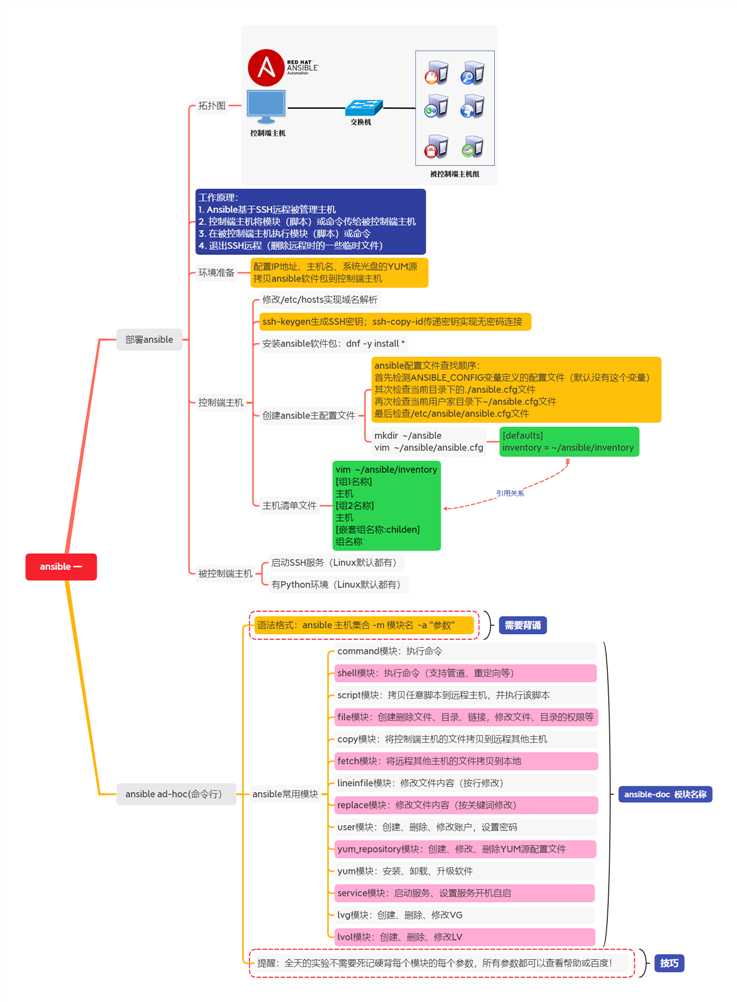
附加思考题(假设在没有创建ssh密钥的情况下):
在没有创建ssh密钥的情况下,如果node1需要ssh远程node2是否需要输入密码?
如果node1需要ssh远程node2,应该输入谁的用户名和密码?
node1使用自己系统的账户和密码能否ssh远程node2,node2可以被随便登录还安全吗?
路人甲能否使用自己家的钥匙,去路人乙家(开路人乙家的门)?
node1执行命令ssh root@192.168.4.12,这里的root是谁的账户名?输入谁的密码?
如果使用真机windows的Xshell去ssh远程node2虚拟机,需要在windows也有一个root用户吗?
-----------------------------------------------------------------------------------------------------------------------------
记录:部署Ansible,Ansible ad-hoc应用(1
标签:nbsp mamicode rip lvs group 开启 免密 nec 远程连接
原文地址:https://www.cnblogs.com/pineliao/p/13379327.html